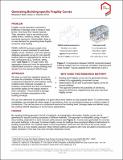| dc.description.abstract | Fragility curves represent a structure’s likelihood of damage under a range of load levels—like those from natural hazards. They, therefore, help to set building code safety factors, resiliency ratings, and even insurance premiums. Unfortunately, there is no real standard for generating these fragility curves for wind loading. FEMA’s HAZUS hurricane model is the closest to a current standard for wind-load fragility curves. However, even this rigorous database generates curves for only specific building types by aggregating the curves of their components (e.g., windows, siding, roof) (see Figure 1). Though useful, this aggregation approach limits the generation of customizable curves for unique buildings that deviate from the standard HAZUS types. | en_US |
